Place of origin West Africa | ||
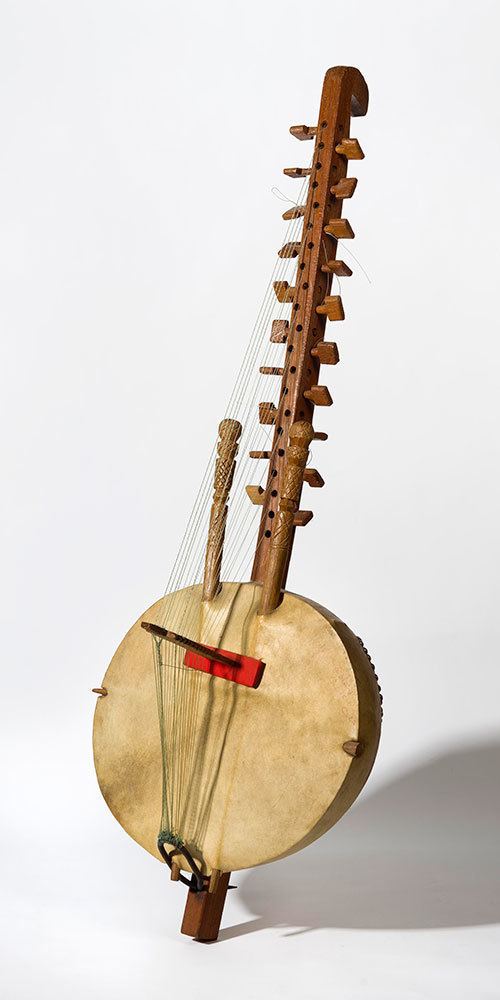 | ||
Classification West African stringed instrument with 21 strings Instrument family string instrument, Plucked String instrument | ||
Kora Instrument
The kora is a 21-string lute-bridge-harp used extensively in West Africa.
Contents
- Kora Instrument
- Description
- History
- Scores
- African composers oral tradition
- Western composers written music
- Notable kora players
- References
Description

A kora is a Mandinka harp built from a large calabash cut in half and covered with cow skin to make a resonator with a long hardwood neck. The skin is supported by two handles that run under it. It supports a notched double free-standing bridge. It doesn't fit into any one category of musical instruments, but rather several, and must be classified as a "double-bridge-harp-lute". The strings run in two divided ranks, making it a double harp. They do not end in a soundboard but are held in notches on a bridge, making it a bridge harp. They originate from a string arm or neck and cross a bridge directly supported by a resonating chamber, making it a lute too.
The sound of a kora resembles that of a harp, though when played in the traditional style, it bears a closer resemblance to flamenco and Delta blues guitar techniques. The player uses only the thumb and index finger of both hands to pluck the strings in polyrhythmic patterns (using the remaining fingers to secure the instrument by holding the hand posts on either side of the strings). Ostinato riffs ("Kumbengo") and improvised solo runs ("Birimintingo") are played at the same time by skilled players.
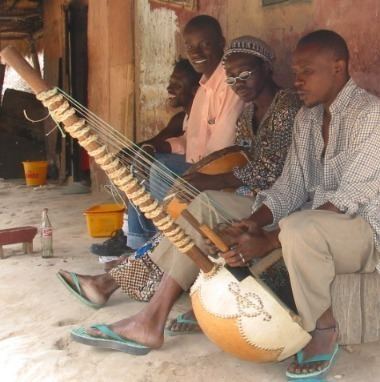
Kora players have traditionally come from Griot families (also from the Mandinka nationalities) who are traditional historians, genealogists and storytellers who pass their skills on to their descendants. The instrument is played in Guinea, Guinea-Bissau, Mali, Senegal, Burkina Faso and the Gambia. A traditional kora player is called a jali, similar to a 'bard' or oral historian. Most West African musicians prefer the term 'jali' to 'griot', which is the French word.
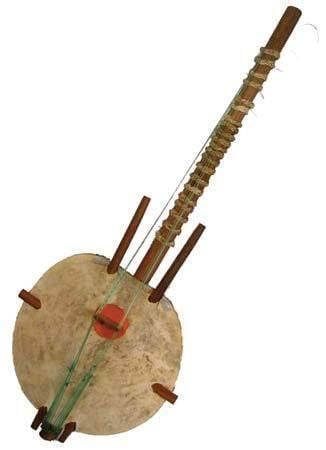
Traditional koras feature 21 strings, eleven played by the left hand and ten by the right. Modern koras made in the Casamance region of southern Senegal sometimes feature additional bass strings, adding up to four strings to the traditional 21. Strings were traditionally made from thin strips of hide, for example antelope skin - now most strings are made from harp strings or nylon fishing line, sometimes plaited together to create thicker strings.
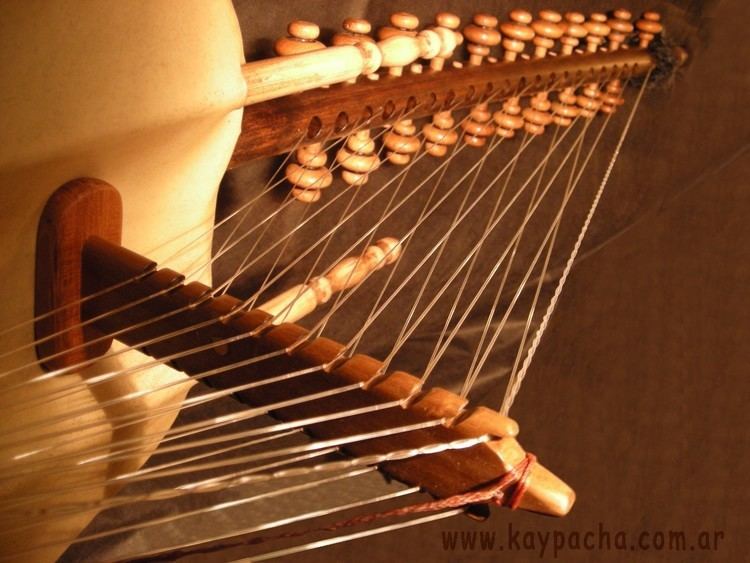
A vital accessory in the past was the nyenyemo, a leaf-shaped plate of tin or brass with wire loops threaded around the edge. Clamped to the bridge, it produced sympathetic sounds, serving as an amplifier since the sound carried well in the open air. In today's environment players usually prefer or need an electric pickup.
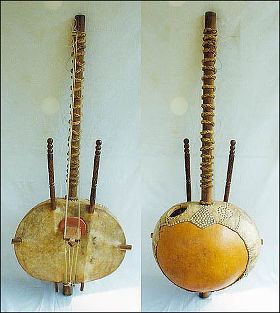
By moving leather tuning rings up and down the neck, a kora player can retune the instrument into one of four seven-note scales. These scales are close in tuning to western major, minor and Lydian modes.
History
The earliest European reference to the kora in Western literature is in Travels in Interior Districts of Africa (1799) by the Scottish Mungo Park. The most likely scenario, based on Mandinka oral tradition, suggests that the origins of the Kora may ultimately be linked with Jali Mady Fouling Cissoko, some time after the founding of Kaabu in the 16th century.
The kora is mentioned in the Senegalese national anthem "Pincez Tous vos Koras, Frappez les Balafons".
Nowadays, increasingly, koras are made with guitar machine heads instead of the traditional leather rings. The advantage is that they are much easier to tune. The disadvantage is that this design limits the pitch of the instrument because string lengths are more fixed and lighter strings are needed to lift it much more than a tone. Learning to tune a traditional kora is arguably as difficult as learning to play it, and many people entranced by the sound while in Africa buy a kora and then find themselves unable to keep it in tune once they are home, relegating it to the status of ornament. Koras can be converted to replace the leather rings with machine heads. Wooden pegs and harp pegs are also used, but both can still cause tuning problems in damper climates unless made with great skill.
In the late 20th century, a 25-string model of the kora was developed, though it has been adopted by only a few players, primarily in the region of Casamance, in southern Senegal. Some kora players such as Seckou Keita have double necked koras, allowing them to switch from one tuning to another within seconds, giving them increased flexibility.
The French Benedictine monks of the Keur Moussa Abbey in Senegal (who possibly were the first to introduce guitar machine heads instead of leather rings in the late seventies) conceived a method based on scores to teach the instrument. Brother Dominique Catta, choirmaster of the Keur Moussa Abbey, was the first Western composer who wrote for the kora (solo pieces as well as duets with Western instruments).
An electric instrument modeled on the kora (but made primarily of metal) called the gravikord was invented in the late 20th century by instrument builder and musician Robert Grawi. It has 24 strings but is tuned and played differently than the kora. Another instrument, the Gravi-kora, a 21 string electro-acoustic instrument, was later developed by Robert Grawi especially for kora players who wanted a modern instrument. Its playing and tuning are the same as the traditional kora. The gravi-kora has been adopted by kora players such as Daniel Berkman, Jacques Burtin, and Foday Musa Suso, who featured it in recordings with jazz innovator Herbie Hancock, with his band Mandingo, and on Suso's New World Power album.
Scores
The kora music being part of the oral tradition, its music was not written until the 20th century. The ethnomusicologists were the only ones to note some traditional airs in the normal grand staff method using the G clef and the F clef.
Nowadays, kora scores are written on a single G clef, following the Keur Moussa notation system. This notation system was created for the kora in the late 1970s by Brother Dominique Catta, a monk of the Keur Moussa Monastery (Senegal). The seven low notes that should be written on the F clef are replaced by Arabic or Roman numerals and written on the G clef.
While griots still compose in the traditional way (without writing scores), some Western musicians began to write partitures for the kora and adopted the Keur Moussa notation system at the beginning of the 1980s. More than 200 scores have already been written for kora solo or kora and Western instruments. Two notable Western composers for the kora are Brother Dominique Catta and Jacques Burtin (France), who wrote most of these scores, though composers like Carole Ouellet (Canada), Brother Grégoire Philippe (Monastère de Keur Moussa) and Sister Claire Marie Ledoux (France) contributed with original works.
